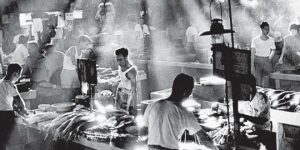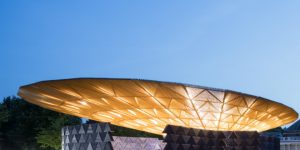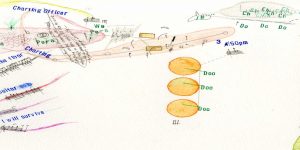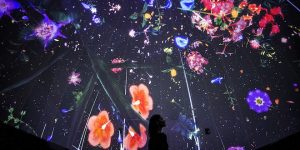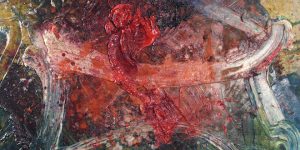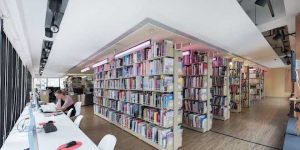Columnist: An insight into the life of Cheong Soo Pieng
Dubbed as Asia’s closest response to Picasso, Chinese artist Cheong Soo Pieng is one of the few who embodies the spirit of modernism.

Artist Cheong Soo Pieng painting in the 1950s.
The history of 20th century modern art is a history of reaction and revision, overcoming and superseding. Throughout the whole extent of their artistic careers, only a few artists can truly claim to possess and embody the totality of the spirit of modernism.
The Chinese émigré artist Cheong Soo Pieng is arguably one such artist. Born in Xiamen and educated in the art academy in Xiamen from 1933, as well as briefly in Shanghai in the mid-1930s before the outbreak of the Sino-Japanese war cut short his education, Cheong migrated to Singapore upon the end of World War II. Working in the culturally barren and artistically inhospitable environment of a post-war tiny nation struggling through national independence and economic development, the odds were stacked against Cheong. But it is perhaps in the face of a comparatively indifferent larger environment that an artist of conviction arises.
The majority who encounter the oeuvre of Cheong Soo Pieng are astounded and confused in equal proportions by the wide spectrum of styles he worked in. Coming across his late period figurative paintings of archetypal Southeast Asian womenfolk in their “natural” rural settings, with their Modigliani-ish almond-shaped eyes and impossibly slender limbs that evoke the classicism of figures developed by the likes of Moore, one would never expect the same artist to be behind hard-edged, minimalism-influenced canvases of the late 1960s and early 1970s where geometric forms signaled introspection and the exploration of emotions.

Cheong Soo Pieng, ‘By the Lotus Pond’, 1980.
If we are focused only on what is demonstrable through the artist’s body of work, without delving into a consideration of the influence an artist might have exerted on his peers and those that follow, it would not be an overstatement to say that Cheong Soo Pieng is Asian modernism’s closest response to Picasso. Like the gargantuan Spanish before him, Cheong Soo Pieng was entirely connected with the shifting zeitgeist of his lifetime. Piecing together Cheong’s stylistic shifts across more than four decades of prolific art-making, one does not see so much gradual evolutionary stylistic shifts as one apprehends astounding, shape-shifting visual transformation taking place every few years.
Turn back the clock to the late 1940s and early 1950s, and we encounter Cheong, a youngish artist trying to make sense of the weight of early 20th-century modern art in an immediate post-war context, applying the complexion of cubism to fresh, unfamiliar subject matter in the equatorial tropics. Fast forward to the early 1960s when Cheong spent time in Europe where abstraction of an expressionist guise held reign over many pockets of the global art world. Cheong explored intuitive painting and the tenets of Art Informel and lyrical abstraction in his works, akin to figures like Georges Mathieu, Zao Wou-Ki or the lesser known Denis Bowen.

Cheong Soo Pieng, ‘Still Life with Mangosteens’, 1955.
For the rest of the 1960s, Cheong cultivated an admirable disregard for convention, deftly marking out and destabilising accepted boundaries by seeking to engage with contradictory notions. He interpreted the essence of Minimalism on his own terms, while crafting and deploying a set of surrealistic pictorial motifs that paid homage to nature. He believed in and applied himself to creating within the flatness of the picture plane, but at the same time delighted in the introduction of industrial materials into his works that jolted the boundaries of painting and sculpture.
In an entirely original fashion, Cheong as master appropriationist began to morph into a proto-conceptualist, serving up deconstructed and reassembled tasters of modern 20th century art, Cheong-style. In the language of 20th century modern art: a little Tanguy surrealism alongside the void of Hepworth and the organic suggestive forms of Miro, in the expansiveness of pictorial spaces pioneered by Rothko and Albers, while ordered and rational like Kandinsky. Cheong straddled painting and sculpture with light-footedness and if there was a single fault to this talent, it was that he never wanted to stay long enough to make an indelible mark in sculpture.

Cheong Soo Pieng, ‘Red Motion’, 1976.
Cheong Soo Pieng the modernist innovator bore a remarkable aptitude for change, but he was equally a man of constancy. From 1960 onwards till the very last works he created, he signed off with a monogram of faux-Chinese character, abiding to the strength of his artistic temperament and philosophy: one of ceaseless experimentation and incessant questioning of the essence of modern art, its apparatuses and expression.
This article was written by Wang Zineng, the founder of Art Agenda, S.E.A.. More information at artagendasea.org.
Catch the exhibition ‘Cheong Soo Pieng: A Centenary Celebration’, on show at Asia Art Centre Taipei I from 11 November to 31 December 2017. The exhibition is organised by Asia Art Centre and Art Agenda, S.E.A., and supported by artcommune gallery, Singapore.




